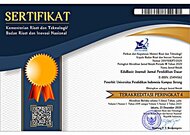Desain Pembelajaran Matematika Berbasis PMRI Pada Materi Perkalian Siswa Kelas 2 Sekolah Dasar
Abstract
Mathematics is one of the subjects studied by students from elementary school to university level. Therefore, mathematics becomes one of the scientific foundations at the basic level. There are some errors that are most often found in learning mathematics in the early grades of elementary school. One of them is related to understanding symbols, place values, process errors and mistakes in doing calculations. The problem is caused because the learning model provided by the teacher is still abstract. The purpose of this research is to provide alternatives learning option with to the design of realistic mathematics education learning or learning based on real life on multiplication material. This writing uses the study of literature from various scientific sources related to the problem. It is hoped that educators can apply mathematical learning models based on the Indonesian Realistic Mathematics Approach (PMRI) or RME (Realistic Mathematics Educatio) non multiplication material by using learning designs based on students' real lives or learning designs. The article shows that there is potential for PMRI design to be used to improve the multiplication ability of elementary school students.
Keywords
Full Text:
PDFReferences
Cooper, H. M. (1998). Synthesizing Research: A Guide for Literature Reviews (Vol. 2). London: Sage.
de Lange, J. (1995). Assesment: No change without problem. In T. A Romberg (Ed). Reform in school matemathics and authentic assesment (pp.87-172). Albany: State University of New York Press.
Depdiknas. (2006). Kurikulum Tingkat Satuan Pendidikan (KTSP). Jakarta: Departmen Pendidikan Nasional
Fink, A. (2014). Conducting Research Literature Reviews: From The Internet to Paper (Fourth edition). Thousand Oaks, California: SAGE.
Hudojo, H. (1990). Strategi Mengajar Belajar Matematika. Malang: IKIP Malang
Imrohma. (2009). Implementasi PMRI untuk Meningkatkan Aktivitas Belajar Matematika pada Siswa Kelas 8 SMPN 4 Malang. Skripsi. Malang: Universitas Negeri Malang
Irawan, A & Febriyanti, C. (2016). Efektifitas Mathmagic dalam peningkatan hasil belajar matematika. FORMATIF: Jurnal Ilmiah Pendidikan MIPA, 6(1 ), 85-92
Jarmita, N. (2015). Kesulitan pemahaman konsep matematis siswa dalam pembelajaran matematika di kelas awal Sekolah Dasar. PIONIR: Jurnal Pendidikan, 4(2), 1-16.
Marrom, S. (2018). Pengembangan desain pembelajaran matematika realistik melalui lesson study berbantuan wolframs matematica. Jurnal Matematika dan Pembelajaran, 6(1), 23-29. doi: 10.33477/mp.v6i1.439.
Sembiring, R. K., Hoogland, K., & Dolk, M. (2010). A Decade of PMRI in Indonesia. Utretch: APS International.
Sembiring, R. K. (2010). Pendidikan matematika realistik Indonesia (PMRI): Perkembangan dan tantangannya. Journal on Mathematics Education, 1(1), 11-16. doi:10.22342/jme.1.1.791.11-16
Treffers, A. (1987). Three Dimensions: A Model of Goal and Theory Description in Mathematics Instruction – The Wiskobas Project. Netherland: Springer
Wijaya, A. (2012). Pendidikan Matematika Realistik. Yogyakarta: Graha Ilmu.
Yusmanita, S., Ikhsan, M., & Zubainur, C. M. (2018). Penerapan pendekatan matematika realistik untuk meningkatkan kemampuan operasi hitung perkalian. Jurnal Elemen, 4(1), 93-104.
Zubairnur, M. C. (2013). Penerapan pendekatan matematika realistik dalam mengkonstruksi algoritma perkalian siswa SD. Jurnal Serambi Ilmu, 3(2), 60-65.
DOI: https://doi.org/10.17509/ebj.v1i1.26178
Refbacks
- There are currently no refbacks.
Copyright (c) 2019 Universitas Pendidikan Indonesia
This work is licensed under a Creative Commons Attribution 4.0 International License.
This journal is indexed by




.png)




.png)
1.png)


1.png)

.png)